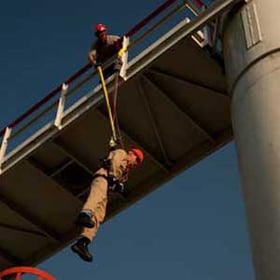On Friday, March 10th at approximately 11:25 AM, the Minnkota Power Rescue Team responded to a “Man Down” call. A scaffolding contractor was in the process of dismantling scaffolding inside a scrubber tower. One of the contractor employees who was working at the top of the scaffolding had a misstep and injured his left knee. The contractor’s serious knee injury prevented him from self-rescuing from the scaffolding.

Minnkota Power’s rescue team was requested to respond. The MPC rescue team is well-trained and well-equipped to respond to both high-angle and confined space emergencies. The team was well-staffed this day with Treavor Hendrickson, Simon Manifold, Trever Himmelspach, Ben Howard, and Dan Imdieke gearing up and arriving on the scene to determine the scope of the emergency. EMTs Laura Fleckenstein and Troy Karlberg also responded to the scene to provide emergency medical care.
Rescue team members made patient contact at the top of the 40-foot scaffold. The patient was assessed and found to have an issue with the left knee, which appeared to be a significant patella dislocation. After the team assessed possible rescue plans, they made the decision to remove the standard Fall Arrest Harness from the patient and assist the patient with donning one of the team member’s Petzl AVAO Class III rescue harness. The Petzl harness would allow rescuers to support the patient in a seated position during removal by using the ventral and sternal D rings.
To support removal from the top of the scaffold, while rescuers provided medical care and changed harnesses, on-scene scaffold contractors installed a header on the top deck of the scaffold to provide high-point anchors for the rescue. Team members rigged a mainline and an anchored Petzl ASAP belay system. Utilizing the knowledge, skills, abilities, and equipment obtained through Roco Rescue training, the MPC Rescue Team loaded the line and seamlessly began the lower.
 Rescuers were placed on the scaffold along the path of travel to guide the patient and prevent further injury. The patient was lowered directly onto a stretcher for quick medical evaluation. The MPC EMTs updated the responding ambulance crew who completed a secondary patient assessment and moved the patient into a waiting ambulance.
Rescuers were placed on the scaffold along the path of travel to guide the patient and prevent further injury. The patient was lowered directly onto a stretcher for quick medical evaluation. The MPC EMTs updated the responding ambulance crew who completed a secondary patient assessment and moved the patient into a waiting ambulance.
From the time the call was received to the time of the patient being safely lowered off the scaffold was less than 30 minutes. The current MPC rescue team consists of 14 members covering multiple shifts. This is the first time in the recent years at the plant that a rope extrication has been utilized to support patient egress. “We are very appreciative of the training and skills obtained during our long partnership with Roco Rescue,” said Rescue Team Program Manager Tim Krous.
Roco Rescue is proud to have played a role in preparing the MPC Rescue Team. We are honored to present Minnkota Power and their talented MPC Rescue Team with the Roco Rescue “Real Rescue” Award.
 Roco Would Like to Recognize Your Outstanding Rope Rescue!
Roco Would Like to Recognize Your Outstanding Rope Rescue!
Nominate your rescue team so we can recognize your professional efforts with a Roco Outstanding Rope Rescue Plaque. All reports that we receive highlighting an actual rescue event will be considered.
Click here to download the Real Rescue Form. You can then email form to info@RocoRescue.com.

 According to the Assistant Secretary for OSHA, Doug Parker, “This national emphasis program aligns all of OSHA's fall protection resources to combat one of the most preventable and significant causes of workplace fatalities...”
According to the Assistant Secretary for OSHA, Doug Parker, “This national emphasis program aligns all of OSHA's fall protection resources to combat one of the most preventable and significant causes of workplace fatalities...”

 3)
3)  5)
5) 

 “A trench collapse can bury workers under thousands of pounds of soil and rocks in seconds, making escape and survival often impossible,” explained OSHA Regional Administrator Bill Donovan in Chicago. “With proper training and use of required safety procedures, incidents like these can be prevented. OSHA and industry employers are working hard to raise awareness of hazards and protective measures and educate employers on how they must protect workers.”
“A trench collapse can bury workers under thousands of pounds of soil and rocks in seconds, making escape and survival often impossible,” explained OSHA Regional Administrator Bill Donovan in Chicago. “With proper training and use of required safety procedures, incidents like these can be prevented. OSHA and industry employers are working hard to raise awareness of hazards and protective measures and educate employers on how they must protect workers.”





